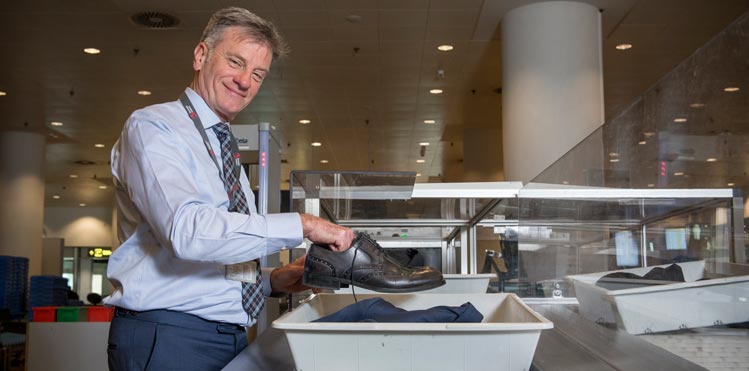Wilfried Covent, Head of Security, Brussels Airport, and Vice-Chair, ACI EUROPE Aviation Security Committee, interviewed by Ross Falconer.

The Belgian Federal Police is introducing new measures to guarantee safety at the airport, as decided by the government. “Brussels Airport has always worked, and is working, very closely with the government and all relevant stakeholders,” comments Wilfried Covent, Head of Security, Brussels Airport, and Vice-Chair, ACI EUROPE Aviation Security Committee. “It’s the role of the airport to provide the equipment and infrastructure that the government and Federal Police seem fit. We can advise and inform them about security measures implemented at other airports.”
Brussels Airport has shown true leadership and resilience in overcoming the terror attack of 22 March. The attack put landside security in the media spotlight, and this will be a focus of the ACI Security & Crisis Management Special Summit, hosted by Brussels Airport.
Wilfried Covent, Head of Security, Brussels Airport, and Vice-Chair, ACI EUROPE Aviation Security Committee, is participating with a paper entitled “The Brussels Airport Attack March 2016 – why airport security will never be the same again.”
In conversation with Airport Business ahead of the Summit, Covent emphasises that landside security at airports is not regulated, nor should it be. “It’s the responsibility of each individual government, with support from the airport operator,” he says. “Protective measures for landside security are a result of continuous security risk assessment, to be adapted to the changing threat level. 100% safety and security cannot be guaranteed. However, mitigating measures should be taken, in keeping with the results of the risk assessment. The government has to validate the mitigating measures. These measures should contribute to smooth passenger flows and at the same time restore passenger and staff confidence.”
The airport’s agile, professional teams responded quickly and efficiently to the terror attack, with a clear and detailed contingency plan. “Both full-scale and table-top emergency drills are conducted at regular intervals to test the plan,” Covent adds. “Our contingency plan proved to work very well after the 22 March attacks. It was very important to take the correct steps.”
There were two stages to the plan:
Stage 1 – Emergency phase:
- Immediate response with focus on rescue
- Crisis management: set up a crisis team
Stage 2 – Recovery phase:
- Temporary structures
- Re-opening terminal, including temporary structures
- 100% capacity in terminal – closing of temporary structures
“During each of these stages, transparent communication is imperative – towards the rescue workers and emergency care workers onsite, towards the work groups that are preparing the restart of operations, towards the government, and the press, etc.” Covent emphasises.
The temporary pre-check tents installed opposite the departures hall were one of the most visible and remarkable measures implemented after the attacks in order to strengthen security in the airport’s public areas. These were disassembled between 24 October and 7 November – an important step in returning to business as usual. “As we are disassembling these structures, we are simultaneously adjusting the entrances to the terminal to improve passenger comfort, while at the same time maintaining a high level of security due to the new measures implemented by the Federal Police,” Covent explains. “It is important that the security measures applied are consistent and do not compromise a smooth passenger process. This is achieved by infrastructural changes, the introduction of additional technology, and the human factor: behaviour detection.”
Passenger experience, security performance and efficiency
Brussels Airport redefined its passenger experience with the opening of the central Connector building in early 2015. This was a big step forward in increasing traveller comfort, and reduced the time taken to get from check-in to boarding gate by 10 minutes. Key to this efficiency is the biggest screening platform in Europe, with 25 screening lanes.
The screening platform, which makes use of the latest technology, is very important in terms of passenger experience, security performance and efficiency. “Passengers enter a structured, well-organised area, which is contributing in a positive way to the passengers’ experience,” Covent says. “Moreover, it uses remote screening. The security agents who monitor the X-ray images are no longer sitting next to the lane, but in a separate control room which allows them better concentration.”
Improving the screening technology, resulting in a higher throughput, is, of course, key for making sure airports can handle growing passenger numbers. “Security rules – EU regulation – should keep the balance between risk, threats, security performance and passenger throughput,” Covent notes. “If you avoid queues, you also reduce the risk – especially landside.”
Meanwhile, Covent is also Vice-Chair of the ACI EUROPE Aviation Security Committee. “Our current priorities include landside security, the methodology used in security risk assessment, the smart security passenger screening lane – where we look into both the technology and the concept of the screening lanes – and the further improvement of the security screening technology,” Covent concludes.







